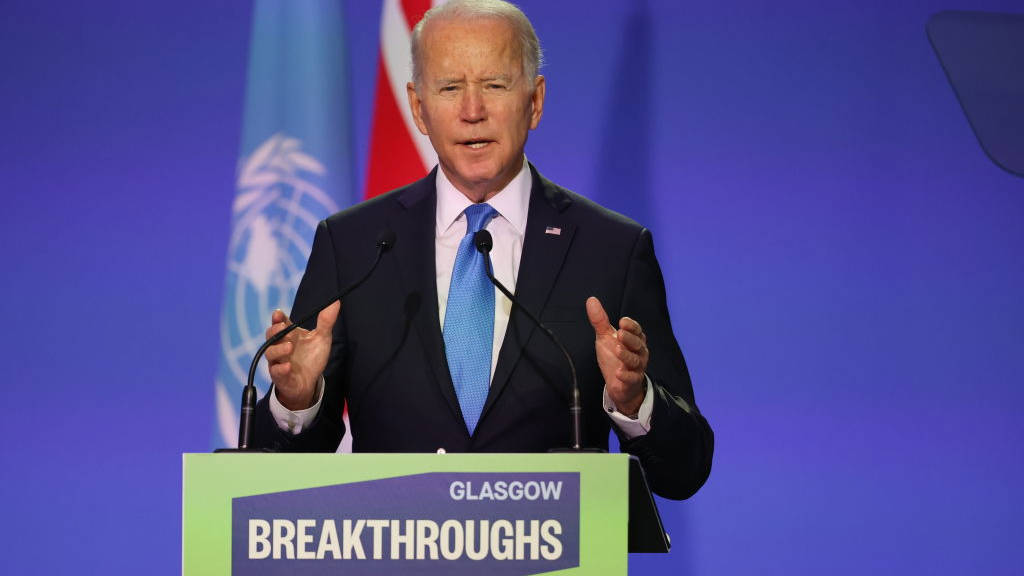Carbon emissions regulation is front and centre at COP26 — can ASX clean-tech companies capitalise?

US President Joe Biden speaks during the World Leaders' Summit "Accelerating Clean Technology Innovation and Deployment" session on day three of COP26. (Photo by Steve Reigate - Pool / Getty Images)
As the second and final week of the COP26 Climate Change Summit gets underway, global warming and the clean energy transition remains a top priority for policy makers and investors.
By this point, investors can agree that the decarbonisation shift is a major long-term trend that will offer plenty of opportunities.
But in the near-term, the investment goalposts are constantly shifting amid the advent of new technologies and the evolving regulatory environment.
Carbon regulations — how much can it do?
On a global level, decarbonisation regulation is also two-speed in nature. For example, among developed economies Europe is often considered to be further along in its policy commitment to the clean energy transition.
But at the company level, “there’s only a certain extent to what changes regulation can really make”, says Haggai Alon, CEO of ASX-listed Security Matters (ASX:SMX).
“It can create a positive environment and offer a regulatory ‘push’, but it can’t make the change.”
At SMX, Alon is developing the application of digitised tracing technology that can be used to track a product across the supply chain — from raw materials, to manufacturing through to recycling.
The company has signed up multiple research partnerships in Europe and Australia over the past 18 months.
In that context, Alon says regulation has helped foster business development, by helping to create a broader sense of urgency. However, it still has its limitations.
“If I can say another thing about regulation — take the Green Deal in Europe as an example — it’s a good thing but it won’t make the change (to the clean energy economy),” he said.
“One of the most complex things about the clean energy transition is the fact that regulation for various reasons always looks at a company or product, and not at the process.”
Until regulation can look at the process, “in my opinion it’s less relevant”, Alon said.
“In the context of our business, the process is about circularity of the value chain – ethical sourcing, product tracing and recycling.”
Broader thinking is required because ultimately “the economy doesn’t go backwards”.
“Is it relevant to talk about a world without commercial flights? Do you think we can have a modern middle class without plastics? No,” Alon says.
“So what we’re focused on is a value chain approach — technology that can replace human auditing and be relevant to the whole ecosystem.”
“And in that sense, the power is really within the companies and clients we work with, not so much the regulators.
“Because these large clients are committed to the change for responsible manufacturing practices, and they will drive it.”
Regulatory tailwinds — a positive case study
Envirosuite (ASX:EVS) is another ASX clean-tech play that’s working with clients amid an evolving regulatory framework.
EVS’ real-time environmental monitoring software measures aspects such as air quality and water quality as part of the manufacturing process.
In comments to Stockhead, Envirosuite CEO Jason Cooper said carbon emission regulations are providing a broad tailwind for its technology in the sense that “the margin for error is far smaller” for quality-control compliance.
In that context, Cooper said clients that operate in sectors such as industrial production or resources are already moving from real-time analytics into predictive solutions.
“Real-time monitoring of an exceedance is already too late, so we want to provide as much notice as possible to plan against such exceedances,” Cooper said.
Instead, “demand will come in the form of accurate forecasting of events and exceedance”.
EVS is trying to position its business model at the forefront of that shift, where currently “many companies still rely on spot monitoring”.
“This is where a company or consultant goes to site to monitor. However, that’s fraught with bias because you can choose when to monitor — (e.g., the lowest incidence times).”
“You can also choose what you monitor, and where you monitor it from — say, at a distance from the emissions.”
In that context, “regulations that drive towards continuous, real-time will help reduce discrepancies, improve auditability and ultimately transparency between the industry and the community,” Cooper said.
New markets?
Lastly, Alon flagged the importance of another development in decarbonisation regulation — the establishment of new tradable asset classes.
Carbon credits are the obvious first example, where Europe has also taken the lead in establishing a broad market with lots of participants.
But SMX also wants to play a role in new markets based on recycling.
“The way I look at it is an opportunity to apply our technology in a marketplace that turns waste products into commodities,” he said.
And it stems from the idea that “climate change doesn’t stop shareholders wanting profits”.
“If you think about all the different types of recycled plastics and metals that go into various applications, then one of the best ways to drive that change is create a full ecosystem of supply and demand with a profit incentive,” Alon said.
In effect, carbon credits won’t be the only tradable assets as the clean energy transition develops.
“Tokenising a carbon credit, that’s easy. What we’re looking at is waste — smart sorting, certifying, and creating new line of commodity that can be bought and sold,” Alon said.
“Making waste commodities tradable as an asset on financial markets will help provide the capital for big companies to complete the transition to a circular economy.”
“At SMX, we’re really trying to lead that shift from carbon credits to recycling credits and playing a role in building out the financial market infrastructure. This is what will fund the transition.”
At Stockhead, we tell it like it is. While Security Matters and Envirosuite are Stockhead advertisers, they did not sponsor this article.
UNLOCK INSIGHTS
Discover the untold stories of emerging ASX stocks.
Daily news and expert analysis, it's free to subscribe.
By proceeding, you confirm you understand that we handle personal information in accordance with our Privacy Policy.








